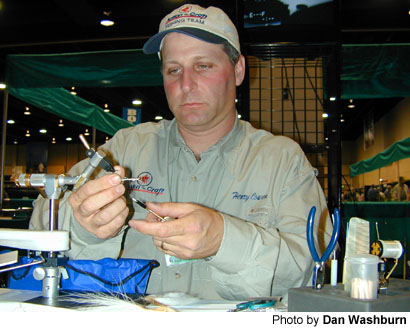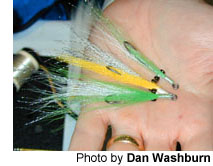
February 27, 2001 — Fly-tying is all about thread control, I was told. However, I’m not sure if thread control matters much to the fish. They’re just looking for something to eat.
But the thread holds it all together — hook, fur, feather, foil — and allows the disparate ingredients to come to life.
“The satisfaction of starting off with a bare hook,” fly designer Henry Cowen gushed, “and turning it into something that the fish thinks is alive — something the fish wants to eat — is really what the kick is all about.”
 I met Cowen, a Gainesville resident, at the Shallow Water Fishing Expo held last weekend at the Gwinnett Civic and Cultural Center in Duluth. The show was an angler’s Eden, the type of place where visitors know to be on the lookout for the occasional miscast fly line.
I met Cowen, a Gainesville resident, at the Shallow Water Fishing Expo held last weekend at the Gwinnett Civic and Cultural Center in Duluth. The show was an angler’s Eden, the type of place where visitors know to be on the lookout for the occasional miscast fly line.
We sat out of striking distance, at a table that appeared prepped for a third-grade art class. Vices sat before us and scissors to our sides. Thread bobbins and bits of bucktail fur lay everywhere. Fly-tying 101 was in session.
Afterward, I was certain of three things: fly-tying is an art, Cowen is an artist … and a column about me learning how to tie a fly would hold the public’s attention about as well as an XFL game.
Thankfully, Cowen is about as unique as they come.
“I used to live with a plugging rod in my hand, a box of lures on my back,” the 42-year-old Cowen said of his youth. This should come as no surprise, of course, because Cowen grew up in that outdoorsman’s paradise known as — wait just a minute — Brooklyn, N.Y.?
Fishing? In the concrete jungle?
“I could walk to the ocean from my house,” continued Cowen — who sounds like a laid-back Rick Pitino when he speaks. “I cut my teeth fishing New York Harbor. Coney Island. Breezy Point. Staten Island.”
Cowen was, in his own words, a “die-hard surf fisherman.” For more than a decade, he waded the coastal waters from Massachusetts to New Jersey searching for striped bass with his spinning rod. He could think of no better way to spend his time.
And then, in 1989, he was introduced to his first fly rod. His life hasn’t been the same since.
Cowen was living on Connecticut’s southwestern coast at the time. Each June, he would watch tiny sand eels attack the shore by the thousands — and hundreds of hungry striped bass chase after them.
“The stripers would come in with their tails in the air,” Cowen remembered. “The water was white with stripers. I went down there with a fly rod one day and I hooked my first one. I never picked up a spinning rod again.”
Now a fly fisherman, Cowen needed flies. He began to tie them himself, and found that he was quite skilled at the craft. By the mid-1990s, his saltwater fly designs were featured in the Orvis catalog — well-liked among outdoors enthusiasts — and various tackle shops throughout the United States.
His patterns were popular, so Cowen was busy. He’d be asked to tie thousands of his flies each year. A tiresome task, especially for someone with a family and full-time job. To this day, Cowen still works as a salesman for a baby clothes manufacturer.
“The orders came in to the point where I was waking up at 4 in the morning just to finish,” Cowen said. “Or I’d have to break out the vice in a plane and tie.”
Cowen now has commercial tiers tie his retail designs for him. Success has its perks. But Cowen continues to tie his personal fly collection.
“It’s relaxing,” Cowen said. “It’s a real nice way to unwind. Instead of grabbing a Scotch on the rocks, I’d rather sit behind a vice.”
 Cowen moved to Gainesville three years ago, and immediately paid local fishing guides to show him the lay of Lake Lanier. They looked at him funny when he’d show up with his fly rod.
Cowen moved to Gainesville three years ago, and immediately paid local fishing guides to show him the lay of Lake Lanier. They looked at him funny when he’d show up with his fly rod.
“What are you going to do, trout fish?” they would ask with skepticism.
Well, Cowen is now a guide himself, one of a select few who can teach you how to fly fish for freshwater stripers on Lanier — and surely the only one with a Brooklyn accent. Right?
“How many other Brooklyn accents are there on the lake?” Cowen repeated with a chuckle. “Fuhgedaboudit.”
By the time my fly-tying lesson came to a finish, I had two Clouser Minnows — perhaps the most versatile of saltwater flies — that I could call my own.
Sure, Cowen’s snips were a little straighter, his wraps more precise. But, I was assured, none of that matters much in the water.
“The cool thing is, fish don’t know the difference between a pretty fly and an ugly fly,” Cowen said. “But that’s beautiful. I mean that. That’s your first fly. That’s a good job.”
We’ll let Lanier’s stripers be the judge of that.
